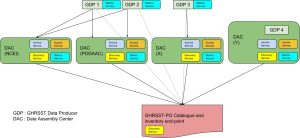The first GHRSST products were made available in 2005. Originally, under the R/GTS, data produced by regional Data Assembly Centres (RDACs) were ingested by a Global Data Assembly Centre (GDAC) and publically distributed via various services. The final archiving and further distribution were performed by the Long-term Stewardship and Reanalysis Facility (LTSRF). The original system has grown more complex with the addition of more DACs and data producers over the years.
A new system, with decentralisation of data ingestion and distribution, was designed in 2022 to prepare GHRSST for future growth and facilitate the integration of new data producers. The implementation of the Central Catalogue was initiated in 2022, supported by EUMETSAT and the European Union Programme Copernicus.
The new framework is illustrated below and is extensively described in the GHRSST R/G TS System Architecture (GSA) report.
In this new system, two entities are involved:
- The data producers, e.g., the GHRSST data producers (GDPs) and
- The distributing centres, e.g., the data assembly centres (DACs).
A list of the data producers (GDPs) and the distributing centres (DACs) is available on this page of the website. If you need to contact the individuals representing these centres and producers, please contact the GHRSST Project Office.

Each DAC implements a minimum set of services for granule data access, search and discovery, production/distribution metrics and long-term archiving.
The GHRSST Central Catalogue hosted on the GHRSST website is maintained by the GHRSST Project Office (GPO) and functions as a Central Catalogue for all GHRSST datasets with a collection of level metadata, and federated search and discovery services. The portal will allow SST users to discover and search all GHRSST products and granules with no need to know the data producer or distributor. All DACs have agreed to provide metadata to the Central Catalogue. The setup will be completed after a beta testing phase. The DACs’ level of readiness to provide data access (HTTP(S), FTP, THREDDS, and OpeNDAP) and granule search (OpenSearch) services have been verified. Most of the DACs are able to provide HTTP(S) and OpenSearch services.
Guidelines for data producers and data assembly centres for feeding the Central Catalogue
- A draft manual for working with the Central Catalogue (version 25 May 2023): https://zenodo.org/record/7970974
- A video explaining how the Central Catalogue works: Watch the video
Additional resources
- Piollé, Jean-François. (2020). GHRSST R/G TS System Architecture GSA. Zenodo. https://doi.org/10.5281/zenodo.4926440 GHRSST pioneered a Regional/Global Task Sharing Framework (R/GTS)which uses a scientifically and technically feasible strategy to acquire existing SST data products, add additional information and create a new generation of products in a common format https://www.ghrsst.org/about-ghrsst/task-teams/task-team-on-evolution-of-the-regional-global-task-sharing-r-g-ts-tt/
- Piollé, Jean-François, & Armstrong, Ed. (2022, June 27). The evolution of the Regional GHRSST Task sharing: The Central Catalogue. Zenodo. https://doi.org/10.5281/zenodo.7189430 https://zenodo.org/record/7189430
- The Recommended GHRSST Data Specification (GDS 2.1) update of August 2022: The GHRSST Data Processing Specification (GDS) provides a detailed technical specification for producing GHRSST L2, L3 and L4 products. The latest version of this document is the GDS 2.1 version 0, published in summer 2022. The document has been updated extensively in this version. Cite as: The Group for High Resolution Sea Surface Temperature Science Team, Piollé, Jean-François, Armstrong, Ed, Casey, Kenneth, & Donlon, Craig. (2022). The Recommended GHRSST Data Specification (GDS) (GDS 2.1 revision 0). Zenodo. https://doi.org/10.5281/zenodo.6984989
